Financial Risk Exposures Analysis: Global Fund Managers Ltd Report
VerifiedAdded on 2020/03/16
|6
|1437
|38
Report
AI Summary
This report provides a detailed analysis of the financial risk exposures faced by Global Fund Managers Ltd (GFML). It identifies and discusses key risks including marketing risks (due to market and rate changes), credit risk (related to client credit), and liquidity risk (the ability to convert assets to cash). The report examines the impact of these risks on GFML, especially concerning foreign exchange rates, interest rates, and the value of bonds. It also assesses the use of bills and bonds as securities and their associated costs. The report recommends hedging all identified risks and suggests the use of derivative instruments such as lower interest rates on bonds and hedging exchange rates. The conclusion emphasizes the importance of managing credit, liquidity, and financial risks to ensure the company's financial stability and success, supported by references to relevant financial literature.
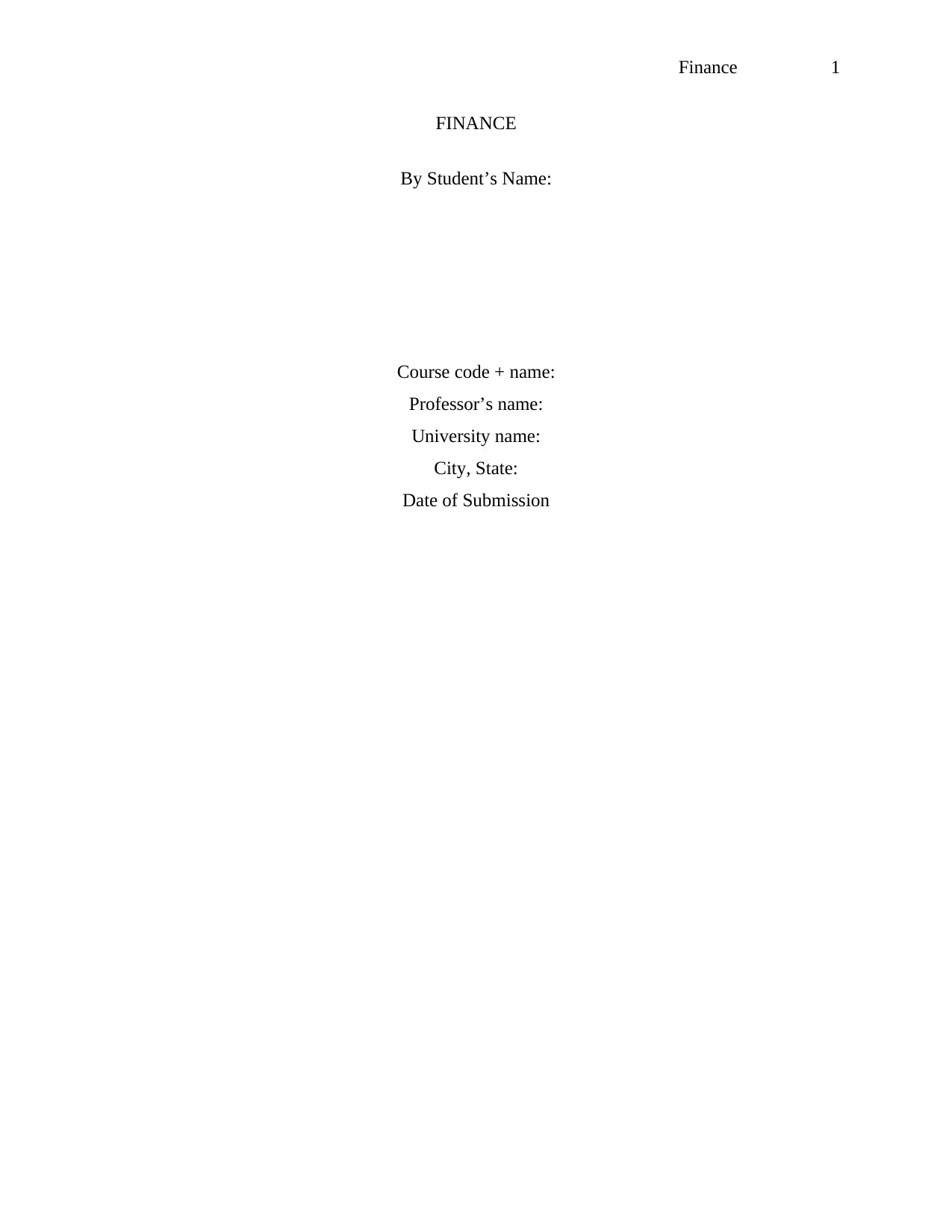
Finance 1
FINANCE
By Student’s Name:
Course code + name:
Professor’s name:
University name:
City, State:
Date of Submission
FINANCE
By Student’s Name:
Course code + name:
Professor’s name:
University name:
City, State:
Date of Submission
Paraphrase This Document
Need a fresh take? Get an instant paraphrase of this document with our AI Paraphraser
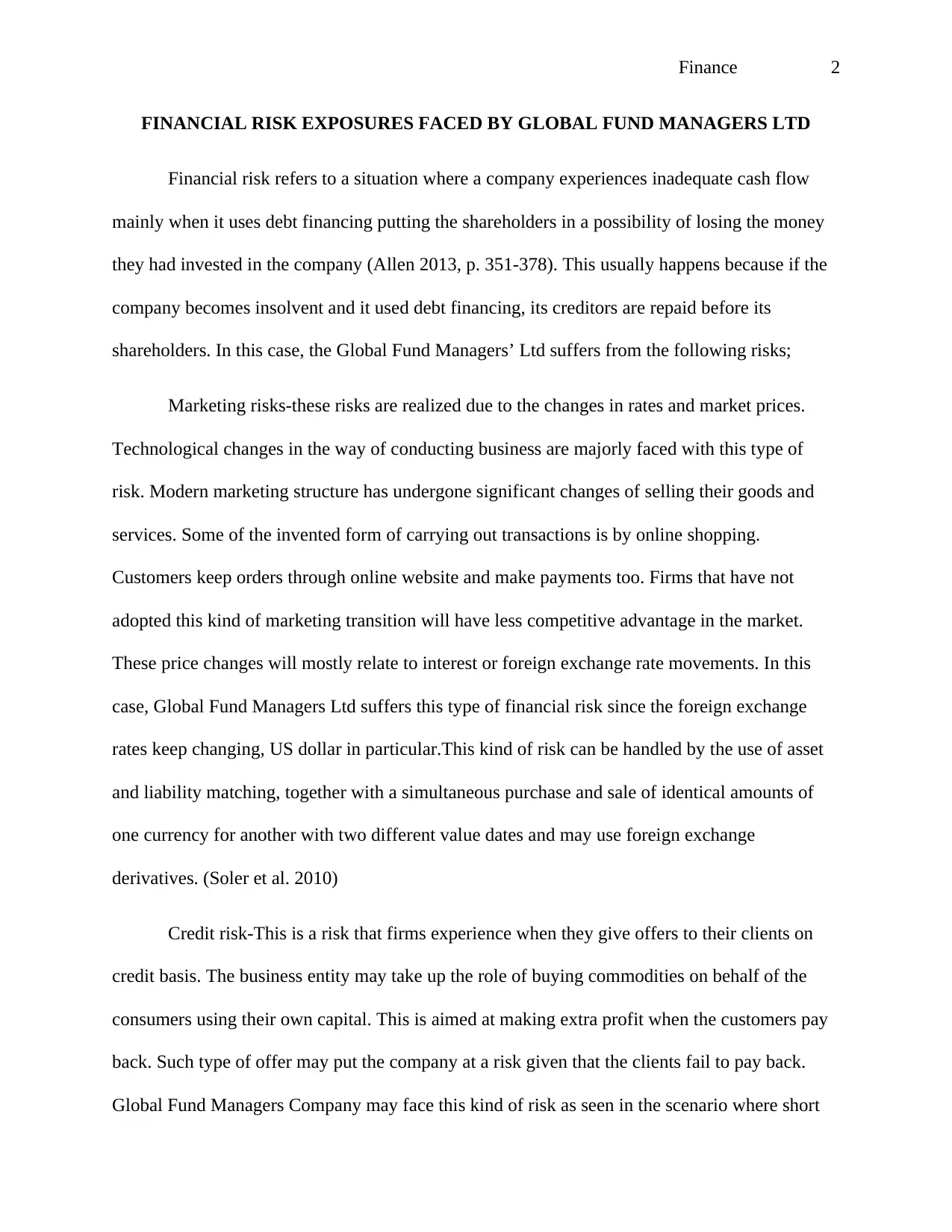
Finance 2
FINANCIAL RISK EXPOSURES FACED BY GLOBAL FUND MANAGERS LTD
Financial risk refers to a situation where a company experiences inadequate cash flow
mainly when it uses debt financing putting the shareholders in a possibility of losing the money
they had invested in the company (Allen 2013, p. 351-378). This usually happens because if the
company becomes insolvent and it used debt financing, its creditors are repaid before its
shareholders. In this case, the Global Fund Managers’ Ltd suffers from the following risks;
Marketing risks-these risks are realized due to the changes in rates and market prices.
Technological changes in the way of conducting business are majorly faced with this type of
risk. Modern marketing structure has undergone significant changes of selling their goods and
services. Some of the invented form of carrying out transactions is by online shopping.
Customers keep orders through online website and make payments too. Firms that have not
adopted this kind of marketing transition will have less competitive advantage in the market.
These price changes will mostly relate to interest or foreign exchange rate movements. In this
case, Global Fund Managers Ltd suffers this type of financial risk since the foreign exchange
rates keep changing, US dollar in particular.This kind of risk can be handled by the use of asset
and liability matching, together with a simultaneous purchase and sale of identical amounts of
one currency for another with two different value dates and may use foreign exchange
derivatives. (Soler et al. 2010)
Credit risk-This is a risk that firms experience when they give offers to their clients on
credit basis. The business entity may take up the role of buying commodities on behalf of the
consumers using their own capital. This is aimed at making extra profit when the customers pay
back. Such type of offer may put the company at a risk given that the clients fail to pay back.
Global Fund Managers Company may face this kind of risk as seen in the scenario where short
FINANCIAL RISK EXPOSURES FACED BY GLOBAL FUND MANAGERS LTD
Financial risk refers to a situation where a company experiences inadequate cash flow
mainly when it uses debt financing putting the shareholders in a possibility of losing the money
they had invested in the company (Allen 2013, p. 351-378). This usually happens because if the
company becomes insolvent and it used debt financing, its creditors are repaid before its
shareholders. In this case, the Global Fund Managers’ Ltd suffers from the following risks;
Marketing risks-these risks are realized due to the changes in rates and market prices.
Technological changes in the way of conducting business are majorly faced with this type of
risk. Modern marketing structure has undergone significant changes of selling their goods and
services. Some of the invented form of carrying out transactions is by online shopping.
Customers keep orders through online website and make payments too. Firms that have not
adopted this kind of marketing transition will have less competitive advantage in the market.
These price changes will mostly relate to interest or foreign exchange rate movements. In this
case, Global Fund Managers Ltd suffers this type of financial risk since the foreign exchange
rates keep changing, US dollar in particular.This kind of risk can be handled by the use of asset
and liability matching, together with a simultaneous purchase and sale of identical amounts of
one currency for another with two different value dates and may use foreign exchange
derivatives. (Soler et al. 2010)
Credit risk-This is a risk that firms experience when they give offers to their clients on
credit basis. The business entity may take up the role of buying commodities on behalf of the
consumers using their own capital. This is aimed at making extra profit when the customers pay
back. Such type of offer may put the company at a risk given that the clients fail to pay back.
Global Fund Managers Company may face this kind of risk as seen in the scenario where short
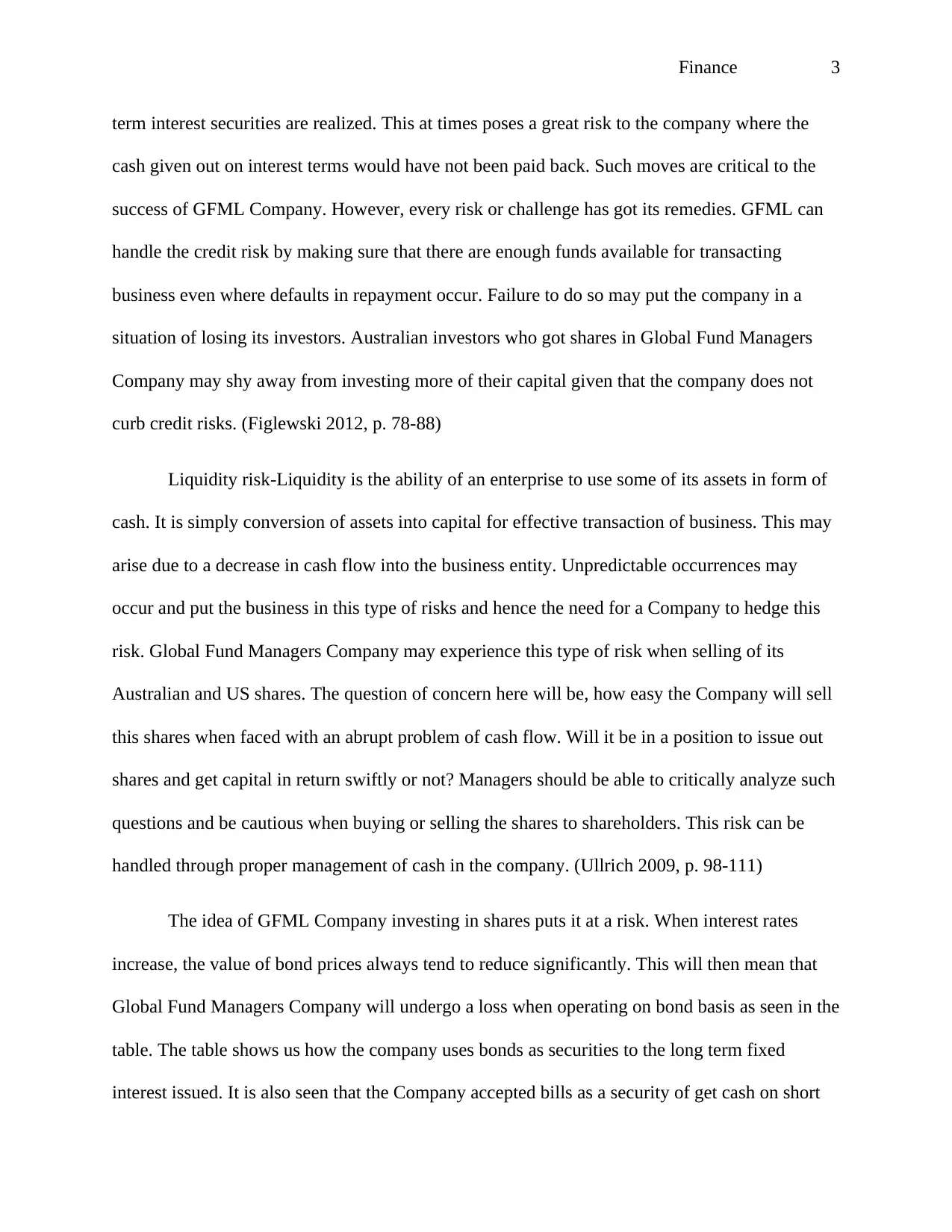
Finance 3
term interest securities are realized. This at times poses a great risk to the company where the
cash given out on interest terms would have not been paid back. Such moves are critical to the
success of GFML Company. However, every risk or challenge has got its remedies. GFML can
handle the credit risk by making sure that there are enough funds available for transacting
business even where defaults in repayment occur. Failure to do so may put the company in a
situation of losing its investors. Australian investors who got shares in Global Fund Managers
Company may shy away from investing more of their capital given that the company does not
curb credit risks. (Figlewski 2012, p. 78-88)
Liquidity risk-Liquidity is the ability of an enterprise to use some of its assets in form of
cash. It is simply conversion of assets into capital for effective transaction of business. This may
arise due to a decrease in cash flow into the business entity. Unpredictable occurrences may
occur and put the business in this type of risks and hence the need for a Company to hedge this
risk. Global Fund Managers Company may experience this type of risk when selling of its
Australian and US shares. The question of concern here will be, how easy the Company will sell
this shares when faced with an abrupt problem of cash flow. Will it be in a position to issue out
shares and get capital in return swiftly or not? Managers should be able to critically analyze such
questions and be cautious when buying or selling the shares to shareholders. This risk can be
handled through proper management of cash in the company. (Ullrich 2009, p. 98-111)
The idea of GFML Company investing in shares puts it at a risk. When interest rates
increase, the value of bond prices always tend to reduce significantly. This will then mean that
Global Fund Managers Company will undergo a loss when operating on bond basis as seen in the
table. The table shows us how the company uses bonds as securities to the long term fixed
interest issued. It is also seen that the Company accepted bills as a security of get cash on short
term interest securities are realized. This at times poses a great risk to the company where the
cash given out on interest terms would have not been paid back. Such moves are critical to the
success of GFML Company. However, every risk or challenge has got its remedies. GFML can
handle the credit risk by making sure that there are enough funds available for transacting
business even where defaults in repayment occur. Failure to do so may put the company in a
situation of losing its investors. Australian investors who got shares in Global Fund Managers
Company may shy away from investing more of their capital given that the company does not
curb credit risks. (Figlewski 2012, p. 78-88)
Liquidity risk-Liquidity is the ability of an enterprise to use some of its assets in form of
cash. It is simply conversion of assets into capital for effective transaction of business. This may
arise due to a decrease in cash flow into the business entity. Unpredictable occurrences may
occur and put the business in this type of risks and hence the need for a Company to hedge this
risk. Global Fund Managers Company may experience this type of risk when selling of its
Australian and US shares. The question of concern here will be, how easy the Company will sell
this shares when faced with an abrupt problem of cash flow. Will it be in a position to issue out
shares and get capital in return swiftly or not? Managers should be able to critically analyze such
questions and be cautious when buying or selling the shares to shareholders. This risk can be
handled through proper management of cash in the company. (Ullrich 2009, p. 98-111)
The idea of GFML Company investing in shares puts it at a risk. When interest rates
increase, the value of bond prices always tend to reduce significantly. This will then mean that
Global Fund Managers Company will undergo a loss when operating on bond basis as seen in the
table. The table shows us how the company uses bonds as securities to the long term fixed
interest issued. It is also seen that the Company accepted bills as a security of get cash on short
⊘ This is a preview!⊘
Do you want full access?
Subscribe today to unlock all pages.

Trusted by 1+ million students worldwide
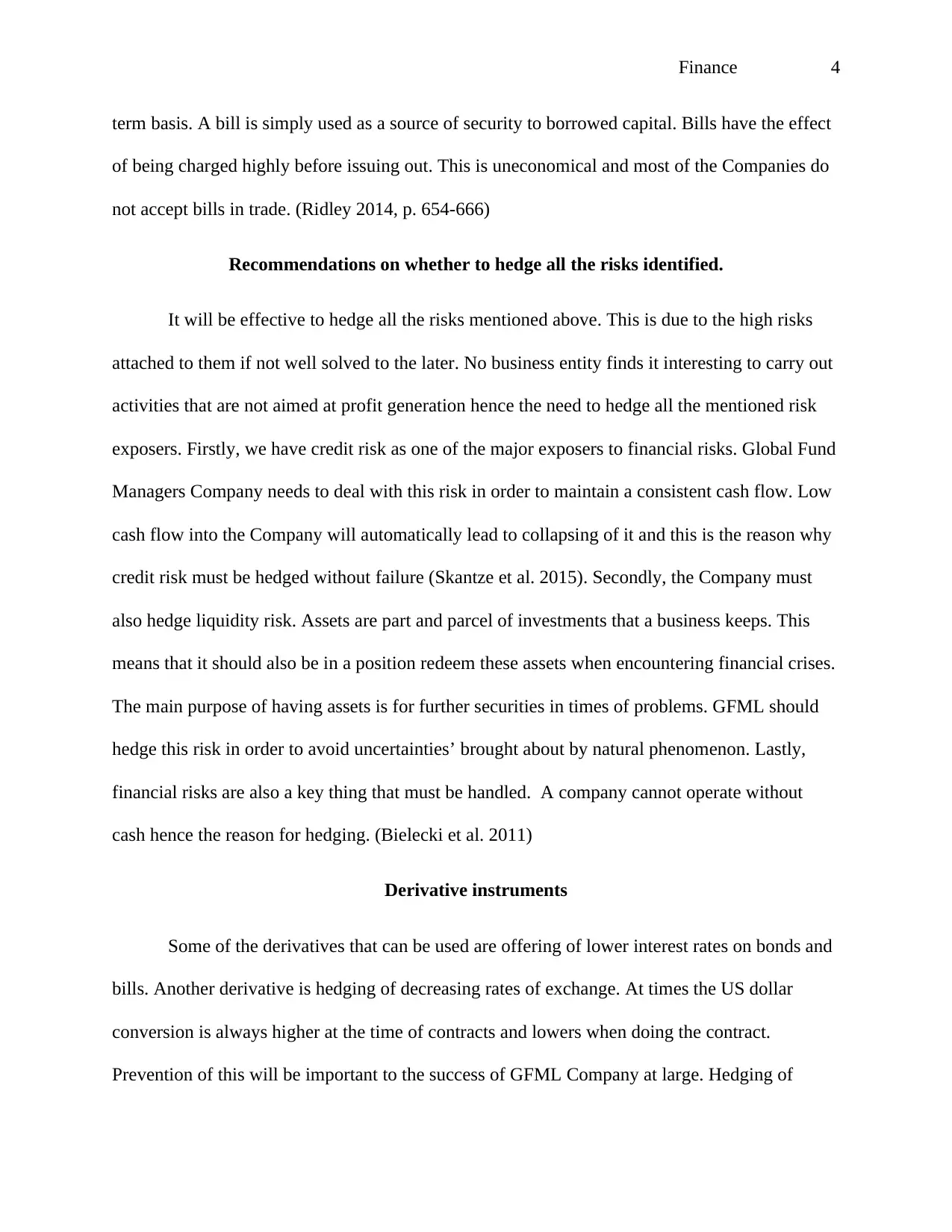
Finance 4
term basis. A bill is simply used as a source of security to borrowed capital. Bills have the effect
of being charged highly before issuing out. This is uneconomical and most of the Companies do
not accept bills in trade. (Ridley 2014, p. 654-666)
Recommendations on whether to hedge all the risks identified.
It will be effective to hedge all the risks mentioned above. This is due to the high risks
attached to them if not well solved to the later. No business entity finds it interesting to carry out
activities that are not aimed at profit generation hence the need to hedge all the mentioned risk
exposers. Firstly, we have credit risk as one of the major exposers to financial risks. Global Fund
Managers Company needs to deal with this risk in order to maintain a consistent cash flow. Low
cash flow into the Company will automatically lead to collapsing of it and this is the reason why
credit risk must be hedged without failure (Skantze et al. 2015). Secondly, the Company must
also hedge liquidity risk. Assets are part and parcel of investments that a business keeps. This
means that it should also be in a position redeem these assets when encountering financial crises.
The main purpose of having assets is for further securities in times of problems. GFML should
hedge this risk in order to avoid uncertainties’ brought about by natural phenomenon. Lastly,
financial risks are also a key thing that must be handled. A company cannot operate without
cash hence the reason for hedging. (Bielecki et al. 2011)
Derivative instruments
Some of the derivatives that can be used are offering of lower interest rates on bonds and
bills. Another derivative is hedging of decreasing rates of exchange. At times the US dollar
conversion is always higher at the time of contracts and lowers when doing the contract.
Prevention of this will be important to the success of GFML Company at large. Hedging of
term basis. A bill is simply used as a source of security to borrowed capital. Bills have the effect
of being charged highly before issuing out. This is uneconomical and most of the Companies do
not accept bills in trade. (Ridley 2014, p. 654-666)
Recommendations on whether to hedge all the risks identified.
It will be effective to hedge all the risks mentioned above. This is due to the high risks
attached to them if not well solved to the later. No business entity finds it interesting to carry out
activities that are not aimed at profit generation hence the need to hedge all the mentioned risk
exposers. Firstly, we have credit risk as one of the major exposers to financial risks. Global Fund
Managers Company needs to deal with this risk in order to maintain a consistent cash flow. Low
cash flow into the Company will automatically lead to collapsing of it and this is the reason why
credit risk must be hedged without failure (Skantze et al. 2015). Secondly, the Company must
also hedge liquidity risk. Assets are part and parcel of investments that a business keeps. This
means that it should also be in a position redeem these assets when encountering financial crises.
The main purpose of having assets is for further securities in times of problems. GFML should
hedge this risk in order to avoid uncertainties’ brought about by natural phenomenon. Lastly,
financial risks are also a key thing that must be handled. A company cannot operate without
cash hence the reason for hedging. (Bielecki et al. 2011)
Derivative instruments
Some of the derivatives that can be used are offering of lower interest rates on bonds and
bills. Another derivative is hedging of decreasing rates of exchange. At times the US dollar
conversion is always higher at the time of contracts and lowers when doing the contract.
Prevention of this will be important to the success of GFML Company at large. Hedging of
Paraphrase This Document
Need a fresh take? Get an instant paraphrase of this document with our AI Paraphraser
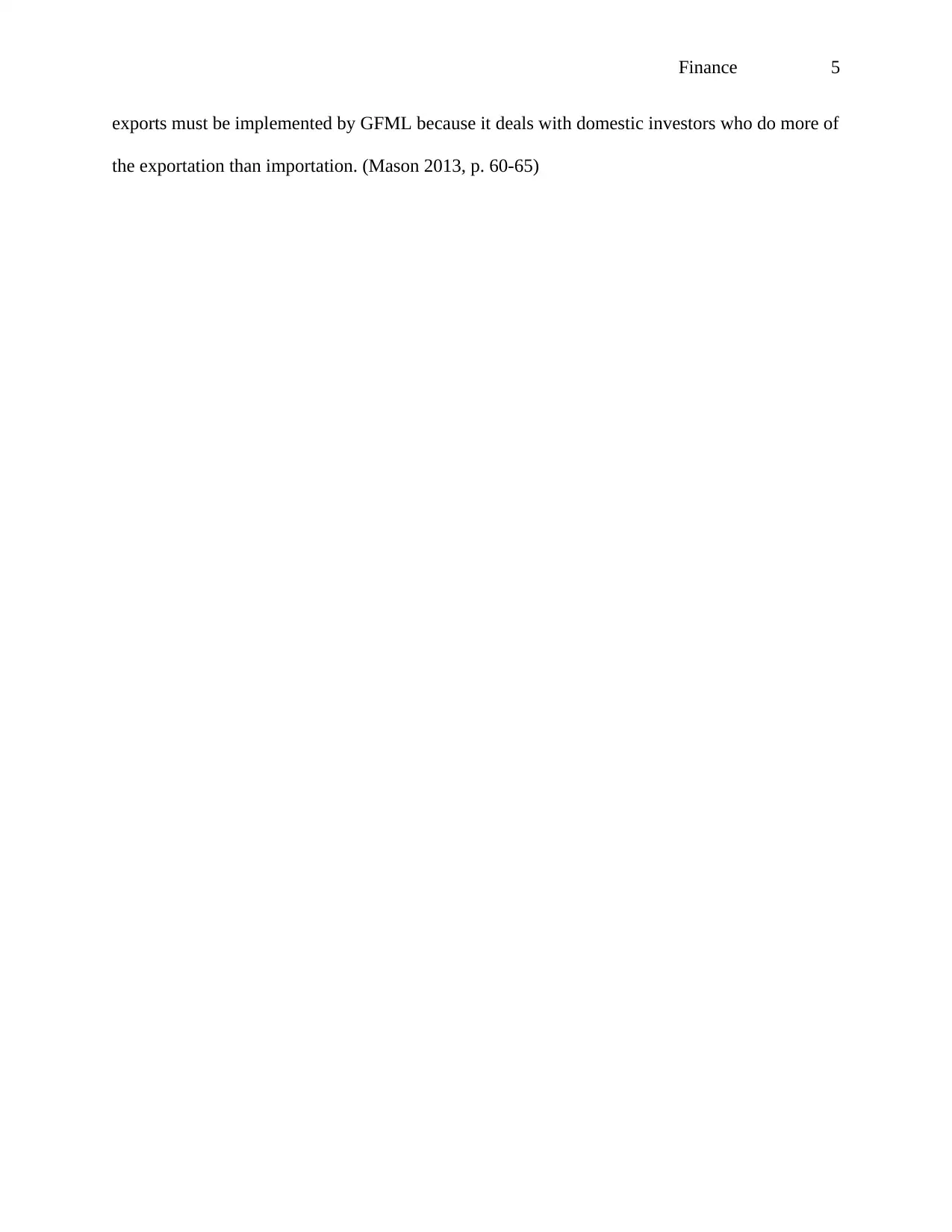
Finance 5
exports must be implemented by GFML because it deals with domestic investors who do more of
the exportation than importation. (Mason 2013, p. 60-65)
exports must be implemented by GFML because it deals with domestic investors who do more of
the exportation than importation. (Mason 2013, p. 60-65)
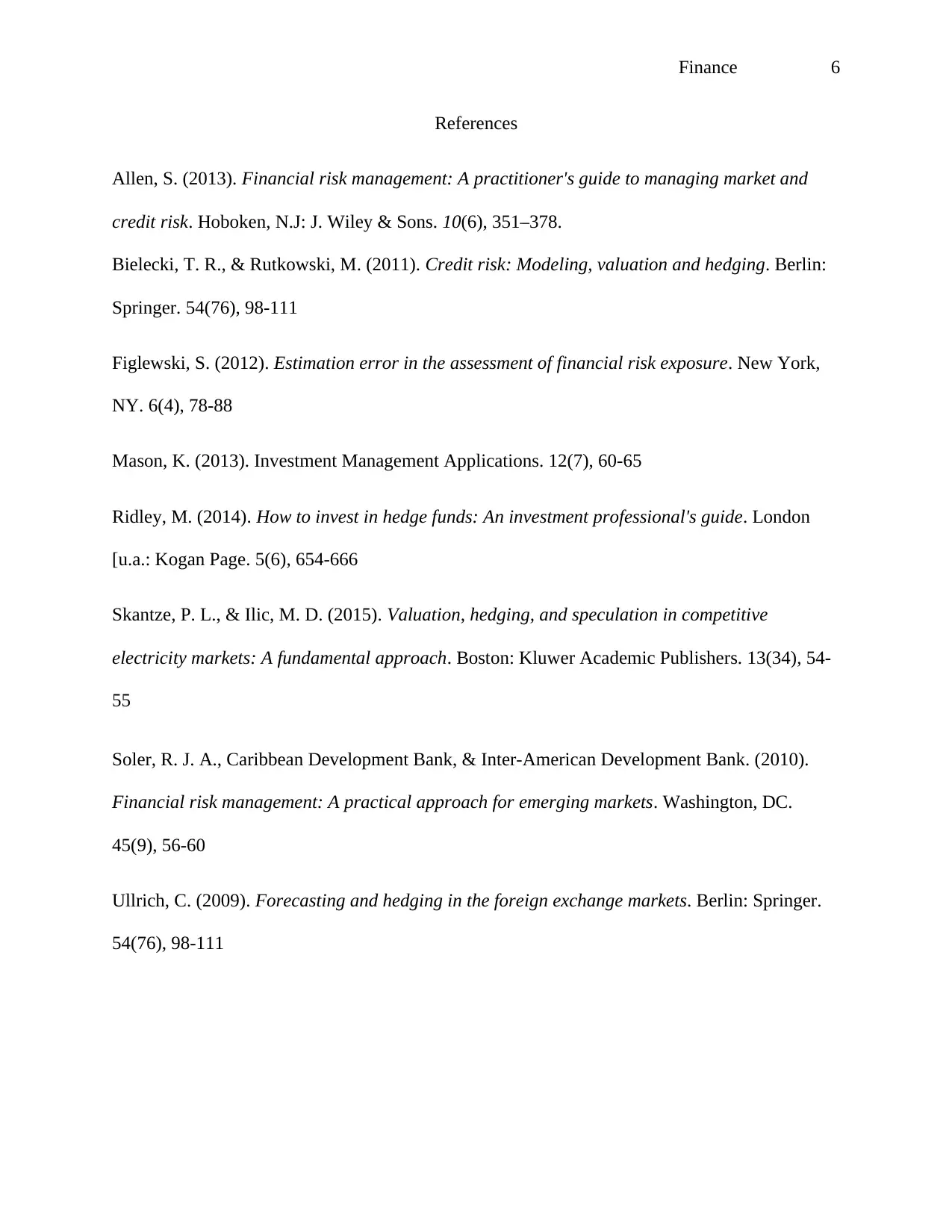
Finance 6
References
Allen, S. (2013). Financial risk management: A practitioner's guide to managing market and
credit risk. Hoboken, N.J: J. Wiley & Sons. 10(6), 351–378.
Bielecki, T. R., & Rutkowski, M. (2011). Credit risk: Modeling, valuation and hedging. Berlin:
Springer. 54(76), 98-111
Figlewski, S. (2012). Estimation error in the assessment of financial risk exposure. New York,
NY. 6(4), 78-88
Mason, K. (2013). Investment Management Applications. 12(7), 60-65
Ridley, M. (2014). How to invest in hedge funds: An investment professional's guide. London
[u.a.: Kogan Page. 5(6), 654-666
Skantze, P. L., & Ilic, M. D. (2015). Valuation, hedging, and speculation in competitive
electricity markets: A fundamental approach. Boston: Kluwer Academic Publishers. 13(34), 54-
55
Soler, R. J. A., Caribbean Development Bank, & Inter-American Development Bank. (2010).
Financial risk management: A practical approach for emerging markets. Washington, DC.
45(9), 56-60
Ullrich, C. (2009). Forecasting and hedging in the foreign exchange markets. Berlin: Springer.
54(76), 98-111
References
Allen, S. (2013). Financial risk management: A practitioner's guide to managing market and
credit risk. Hoboken, N.J: J. Wiley & Sons. 10(6), 351–378.
Bielecki, T. R., & Rutkowski, M. (2011). Credit risk: Modeling, valuation and hedging. Berlin:
Springer. 54(76), 98-111
Figlewski, S. (2012). Estimation error in the assessment of financial risk exposure. New York,
NY. 6(4), 78-88
Mason, K. (2013). Investment Management Applications. 12(7), 60-65
Ridley, M. (2014). How to invest in hedge funds: An investment professional's guide. London
[u.a.: Kogan Page. 5(6), 654-666
Skantze, P. L., & Ilic, M. D. (2015). Valuation, hedging, and speculation in competitive
electricity markets: A fundamental approach. Boston: Kluwer Academic Publishers. 13(34), 54-
55
Soler, R. J. A., Caribbean Development Bank, & Inter-American Development Bank. (2010).
Financial risk management: A practical approach for emerging markets. Washington, DC.
45(9), 56-60
Ullrich, C. (2009). Forecasting and hedging in the foreign exchange markets. Berlin: Springer.
54(76), 98-111
⊘ This is a preview!⊘
Do you want full access?
Subscribe today to unlock all pages.

Trusted by 1+ million students worldwide
1 out of 6
Related Documents
Your All-in-One AI-Powered Toolkit for Academic Success.
+13062052269
info@desklib.com
Available 24*7 on WhatsApp / Email
![[object Object]](/_next/static/media/star-bottom.7253800d.svg)
Unlock your academic potential
Copyright © 2020–2025 A2Z Services. All Rights Reserved. Developed and managed by ZUCOL.




